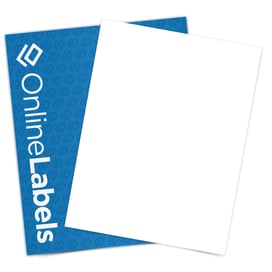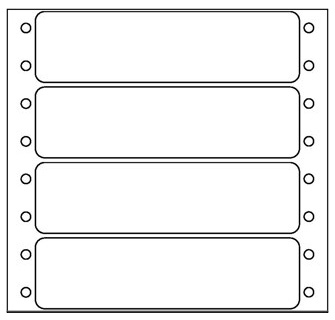Comprehending How Blank Labels Job to Boost Your Labeling Experience
Comprehending the mechanics of blank labels is necessary for maximizing your labeling practices across various contexts. These versatile tools supply considerable benefits, such as modification and versatility, making them a suitable choice for both specialist settings and individual usage. From inventory monitoring to home organization, the ramifications of their critical application can result in boosted efficiency. To fully understand exactly how these labels can change your procedures, one must think about the various kinds readily available and the myriad ways they can be personalized to fit details needs.

Benefits of Making Use Of Blank Labels
Blank labels provide a functional option for various identifying needs, making them indispensable in both individual and expert setups. Their versatility permits users to develop customized labels customized to specific demands, boosting organizational effectiveness. Whether utilized in home workplaces, retail settings, or industrial applications, blank labels assist in the identification and categorization of items, documents, and personal products.
One substantial benefit of blank labels is their cost-effectiveness. By allowing individuals to publish just the labels they require, waste is minimized, and inventory administration ends up being a lot more convenient. Additionally, blank labels work with various printing techniques, including inkjet and printer, making them obtainable for various customers.

Moreover, the usage of blank labels streamlines the process of upgrading information, as individuals can conveniently print new labels to change outdated ones, making sure that all items and files are precisely classified. In general, blank labels offer a functional and reliable labeling service for varied applications.
Sorts Of Blank Labels Available
What options are readily available when it involves blank labels? Blank labels can be found in a variety of kinds, each suited for different applications and preferences. One of the most common kinds consist of paper labels, which are functional and affordable, making them excellent for everyday use. They are offered in numerous coatings, such as matte and shiny, allowing for aesthetic versatility.
Another popular option is synthetic labels, typically made from products like polyester or plastic. These labels are understood for their longevity and resistance to water, chemicals, and tearing, making them ideal for harsh environments. They are commonly used in industrial settings or for labeling products that might be revealed to dampness.
In addition, there are thermal transfer labels, which call for a printer that makes use of warm to transfer ink onto the label surface. These labels are favored for their high-quality print and longevity.
Lastly, specialty labels satisfy details demands, such as detachable labels for short-term use or high-temperature labels for extreme problems. Recognizing these choices allows users to pick one of the most proper blank label for their distinct labeling requirements.
Modification Options for Labels
A large variety of personalization options is readily available for labels, permitting individuals to tailor them to details requirements and branding demands. Individuals can choose from various dimensions, shapes, and products to make sure that the labels efficiently fit their intended objective. Common products include paper, polyester, and plastic, each using different degrees of sturdiness and aesthetic charm.
Color alternatives play an important role in modification, allowing brand names to preserve uniformity with their corporate identification. Users can pick from a spectrum of shades or perhaps choose customized printing to match details branding elements. In addition, labels can be printed with special designs, logos, and message, enhancing brand name acknowledgment and visual effect.
Another crucial facet is the choice of adhesive. Tags can be made with long-term, detachable, or repositionable adhesives, depending on the application demands. This adaptability allows for efficient labeling options throughout various atmospheres, from retail to commercial settings.

Tips for Effective Labeling
Effective labeling goes past customization; it additionally includes tactical considerations that enhance functionality and interaction. To attain effective labeling, start by clearly defining the objective of each tag.
Following, focus on visibility by picking suitable shades and font styles. High comparison between message and background boosts readability, while larger font styles facilitate fast identification. In addition, ensure that labels are placed in a consistent and rational fashion, making it simpler for customers to locate and translate information.
Take into consideration the sturdiness of labels. Pick materials fit for the details environment where the labels will be made use of, discover here whether it be indoors or outdoors. Water resistant or tear-resistant choices might be necessary depending upon the context.
Last but not least, routinely evaluation and upgrade your labels to mirror any changes in info or use. This aggressive approach not only maintains clearness however additionally stays clear of confusion over time. By complying with these ideas, you can maximize the effectiveness of Check Out Your URL your labeling efforts, ensuring they serve their designated function effectively.
Applications of Blank Labels
Blank labels use countless applications throughout numerous sectors, making them a very useful device for company and interaction. These functional labels are generally made use of in stockrooms for supply monitoring, enabling services to quickly determine and track products. By applying blank labels to storage space containers, shelves, or pallets, companies can streamline their operations and lower the chance of mistakes.
In the health care industry, blank labels play a vital role in labeling drugs and clinical materials, guaranteeing proper recognition and usage. Customizable labels can consist of crucial info such as dosage, expiry days, and client details, boosting security and compliance.
In retail, blank labels aid in prices products, supplying promotions, or labeling rack locations, which inevitably improves the customer experience. They permit quick updates to rates or product information without the requirement for pre-printed labels.
Additionally, blank labels are beneficial for individual use, such as arranging office, crafting, or classifying food containers. Their versatility permits individuals to develop tailored remedies that satisfy specific requirements. Overall, the applications of blank labels are comprehensive, underscoring their value in fostering effectiveness and clarity in different setups.
Conclusion
In verdict, blank labels present a flexible and efficient service for numerous labeling requirements. Their adaptability in size, form, and product enables tailored applications throughout official source different atmospheres. By leveraging modification options and efficient labeling approaches, organizations can enhance clearness and interaction (Blank Labels). Ultimately, the combination of blank labels right into functional procedures adds to enhanced effectiveness, making them an invaluable resource for both personal and expert usage.